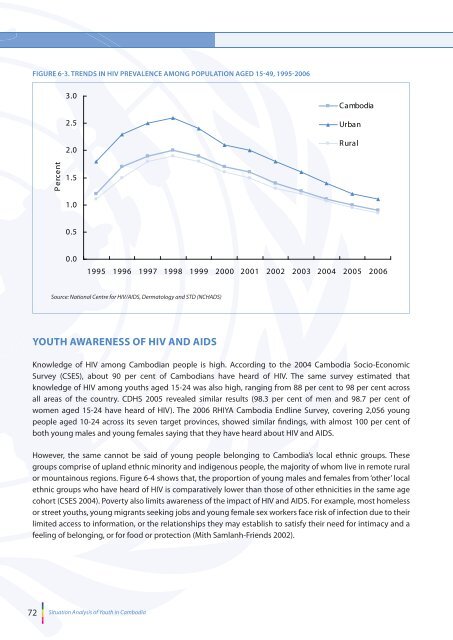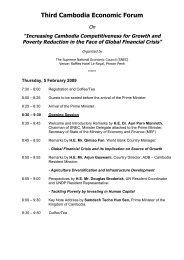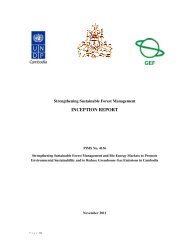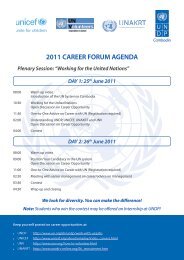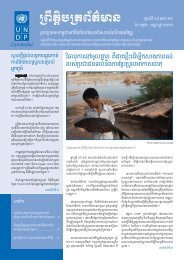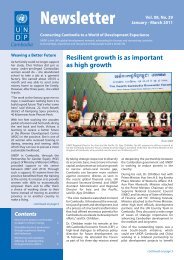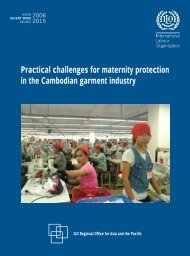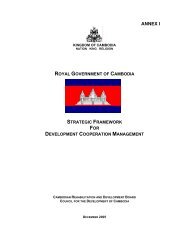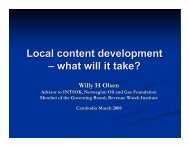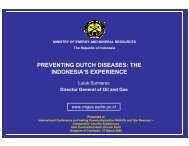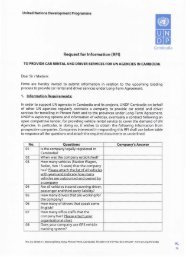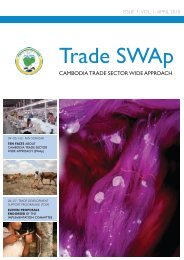UN Analysis Final.pdf - United Nations in Cambodia
UN Analysis Final.pdf - United Nations in Cambodia
UN Analysis Final.pdf - United Nations in Cambodia
You also want an ePaper? Increase the reach of your titles
YUMPU automatically turns print PDFs into web optimized ePapers that Google loves.
FIGURE 6-3. TRENDS IN HIV PREVALENCE AMONG POPULATION AGED 15-49, 1995-2006<br />
3.0<br />
2.5<br />
2.0<br />
<strong>Cambodia</strong><br />
Urban<br />
Rural<br />
Percent<br />
1.5<br />
1.0<br />
0.5<br />
0.0<br />
1995 1996 1997 1998 1999 2000 2001 2002 2003 2004 2005 2006<br />
Source: National Centre for HIV/AIDS, Dermatology and STD (NCHADS)<br />
YOUTH AWARENESS OF HIV AND AIDS<br />
Knowledge of HIV among <strong>Cambodia</strong>n people is high. Accord<strong>in</strong>g to the 2004 <strong>Cambodia</strong> Socio-Economic<br />
Survey (CSES), about 90 per cent of <strong>Cambodia</strong>ns have heard of HIV. The same survey estimated that<br />
knowledge of HIV among youths aged 15-24 was also high, rang<strong>in</strong>g from 88 per cent to 98 per cent across<br />
all areas of the country. CDHS 2005 revealed similar results (98.3 per cent of men and 98.7 per cent of<br />
women aged 15-24 have heard of HIV). The 2006 RHIYA <strong>Cambodia</strong> Endl<strong>in</strong>e Survey, cover<strong>in</strong>g 2,056 young<br />
people aged 10-24 across its seven target prov<strong>in</strong>ces, showed similar f<strong>in</strong>d<strong>in</strong>gs, with almost 100 per cent of<br />
both young males and young females say<strong>in</strong>g that they have heard about HIV and AIDS.<br />
However, the same cannot be said of young people belong<strong>in</strong>g to <strong>Cambodia</strong>’s local ethnic groups. These<br />
groups comprise of upland ethnic m<strong>in</strong>ority and <strong>in</strong>digenous people, the majority of whom live <strong>in</strong> remote rural<br />
or mounta<strong>in</strong>ous regions. Figure 6-4 shows that, the proportion of young males and females from ‘other’ local<br />
ethnic groups who have heard of HIV is comparatively lower than those of other ethnicities <strong>in</strong> the same age<br />
cohort (CSES 2004). Poverty also limits awareness of the impact of HIV and AIDS. For example, most homeless<br />
or street youths, young migrants seek<strong>in</strong>g jobs and young female sex workers face risk of <strong>in</strong>fection due to their<br />
limited access to <strong>in</strong>formation, or the relationships they may establish to satisfy their need for <strong>in</strong>timacy and a<br />
feel<strong>in</strong>g of belong<strong>in</strong>g, or for food or protection (Mith Samlanh-Friends 2002).<br />
72 Situation <strong>Analysis</strong> of Youth <strong>in</strong> <strong>Cambodia</strong>


